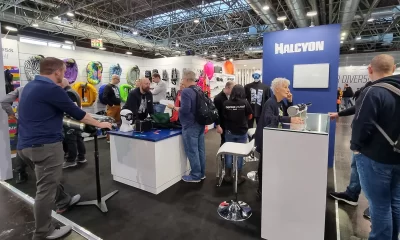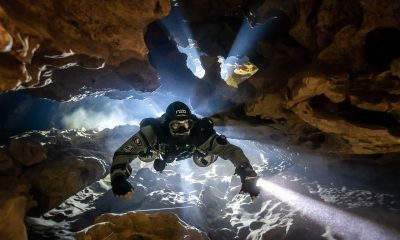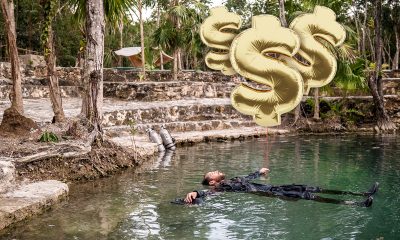
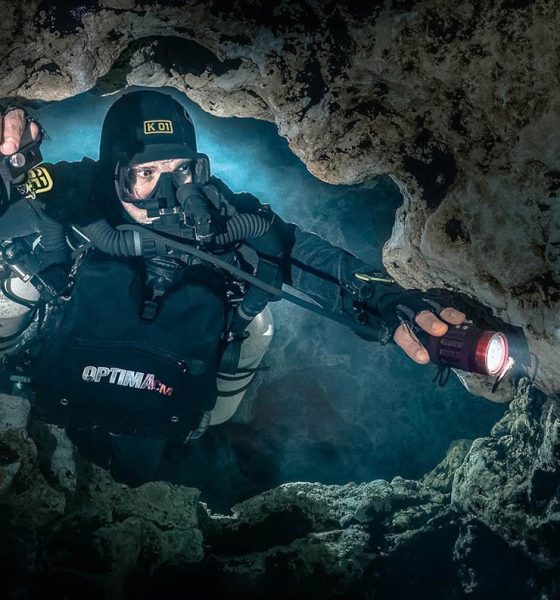
Equipment
Whole Lotta CHO2ptima Going On
Launched in early 2020, just as the pandemic was getting started, Dive Rite’s innovative chest-mounted O2Ptima, aka the CHO2ptima, is generating significant buzz among instructors and users as the hot new rebreather on the market. Accordingly, InDEPTH chief Michael Menduno sat down with general manager Jared Hires to explore Dive Rite’s latest purpose-built creation. Is there a CHO2ptima in your future (carry-on case)?
By Michael Menduno. Header image: Max Kuznetsov going through the Manhole at Ginnie Springs by Fan Ping. Other images courtesy of Dive Rite unless noted. Full disclosure: Dive Rite is a sponsor of InDEPTH.
🎶🎶 Pre-dive Clicklist: A Whole Lotta Shakin’ Going On by Jerry Lee Lewis
Various brands of mixed gas rebreathers have taken their turn in the spotlight over the years as a result of their functionality and innovation. In the early days of the 21st century, it was AP Diving’s pioneering rebreather, the Inspiration, followed by the KISS Classic, and shortly after, Inner Space Corp’s Megalodon that were grabbing all the attention. Later, the rEVO and Hollis PRISM came to prominence. The O2ptima drew attention. Poseidon had its day in the sun when Type R i.e., recreational rebreathers were a thing. Remember them? Of course, in recent years, the JJ-CCR, including GUE’s configuration, the Fathom, and Divesoft’s Liberty—both backmount and sidemount versions—have garnered significant community attention, and still do.
However today, it is arguably Dive Rite’s unique and innovative rebreather, the O2ptima Chest Mount, aka “The CHO2ptima,” which was launched during the early days of the COVID-19 Pandemic, that is receiving considerable buzz in the market and garnering new instructors and users. Ironically, while the community collectively moved to back-mounted counter lungs (CL) to free up chest space, Dive Rite has taken a different approach altogether, and moved its rebreather to the front of the diver, reminiscent of combat divers units (offering optimal CL placement when in trim), and that’s only part of its novelty.
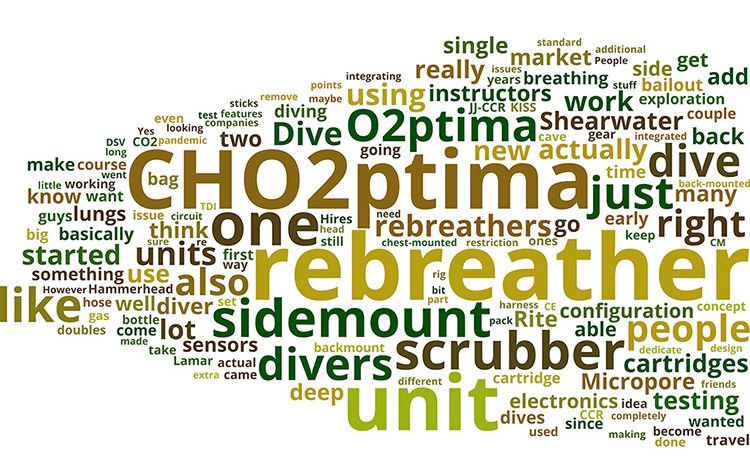
Weighing in at 7.7kg /17 lbs and able to fit in a small carry-on roller case, its compact size along with its ability to interface with practically any open circuit configuration—from Rec to Tec—to drive it, makes CHO2ptima a serious choice in travel rebreathers. As the tagline says, “Dive Rite—Equipment for Serious Divers.” Interestingly, many divers, including some GUE members, are considering the CHO2ptima as their next rebreather.
Accordingly, we reached out to Dive Rite’s 31-year-old General Manager Jared Hires, who has been diving rebreathers since he was 15, to take us for a deep dive into their newest rebreather. Hires, who is an active, advanced Technical Diving International (TDI) tech and CCR instructor, and an apprentice cave instructor with the National Speleological Society-Cave Diving Section (NSS-CDS), explains the philosophy behind the CHO2ptima and its development, discusses its use and applications, and talks about the possibility of getting the unit CE-tested, so it can be sold in Europe.
I conducted the interview with Jared while he was in between duties managing the nearly 40-year old family business, and teaching a CHO2ptima class. Here is what the man had to say.
InDEPTH: Dive Rite launched its O2ptima backmount rebreather in 2006. Then, in March 2020, you launched the O2ptima CM, aka “The CHO2ptima”—a modified O2ptima with chest-mounted counterlungs. I get the distinct impression that the CHO2ptima has surpassed its predecessor’s sales by quite a bit, and there’s considerable buzz around the unit. Is that an accurate characterization?
Jared Hires: The CHO2ptima has gained a lot of attention since its release, and sales have surpassed the backmount version. I think this can be attributed to several different factors. Since the unit is integrated into a diver’s primary gear configuration, they are less apprehensive in making the jump to a CCR. There is less of a learning curve since everything is not new.
Another contributing factor is cost. The CHO2ptima is extremely affordable (by rebreather standards), which is making it more attainable for divers. I would like to think that we have grown the rebreather market, not that we have just taken a larger portion of the pie.

What’s the retail price?
$6,900 with a Shearwater Petrel 3 controller or $7,200 with a NERD 2 Controller.
Wow. That is very affordable. Lamar [Hires] told me that CHO2ptima sales really made a difference during the pandemic!
Releasing a new rebreather at the start of a pandemic was hard. It was difficult to get it out there for people to see and to get instructors up to speed. Somehow, we were able to do it. It was a welcomed addition to our line and helped the business continue to grow through the pandemic. We have been extremely busy.
So, how did the CHO2ptima come about? What was the motivation?
It was a long project—something that we were working on for at least three to four years. During that process, we tried out many different concepts and renditions. It all really stemmed from the fact that sidemount rebreathers had started to become popular, and we had people asking for them. People were wondering if we were going to offer one since we had already made a name for ourselves in sidemount. We were the first to offer a commercially-available sidemount rig and one of the pioneers in sidemount diving. It seemed natural that we also have a spot in the sidemount rebreather market.
I remember some of Lamar’s early sidemount units that he developed with Woody Jasper and Wes Skiles back in the day.
That’s right. Of course, we also had a very strong background in rebreathers working on producing the O2ptima since the mid-2000s and having lots of units on the market. So we started working on a concept.
One of the things that held us back from sidemount rebreathers, especially early on, was the fact that all of the units at the time, like the SF2 or the KISS Sidekick, featured a single sidemount rebreather attached on one side, and most divers, particularly around here, wore a single bailout bottle attached on the other side. And a lot of people still do that. We didn’t really like that idea.
We are cave divers, so it’s all about redundancy. You won’t see many of us going into a cave with only one bailout bottle. Some people in Florida were using a bailout bottle with an H-valve, so they at least had two regulators. That was a little bit better, but there were still quite a few people not carrying what we thought was adequate bailout. So that kind of turned us off on the idea of doing just a straight sidemount unit.
Other integrated sidemount units, like the KISS Sidewinder, which has been really popular, alleviated the issue of bailout because the diver carried a bailout bottle on each side, which provided adequate bailout gas. The drawback was that it had to be completely integrated into your sidemount system. So, it wasn’t something that you could take off mid-dive if you were exploring and had to pass through a tight restriction. You essentially had to dedicate a complete sidemount rig to nothing but that. And we just didn’t like the concept of that either.
The idea was to modify Dive Rite’s O2ptima rebreather, right?
That’s right. We wanted to keep as much of the O2ptima intact as possible—especially the scrubber design—we really liked the Micropore scrubber. It’s always easy to pack consistently. There’s no user interface when it comes to having to pack a scrubber. We also wanted to keep the electronics—we wanted a fully electronically controlled rebreather and not a manual rebreather. We didn’t want to have to sacrifice any of the features that we had come to enjoy on a traditional back-mounted O2ptima. So that’s why we started looking at the chestmount as an option rather than sidemount.
The chestmount would actually allow you to add it to any type of diving system. You could add it to any sidemount harness, you didn’t have to make modifications to an existing sidemount harness,and you didn’t have to worry about integrating it in and dedicating a rig to nothing but that. But it would also work with other configurations like back-mounted doubles or even a single tank.
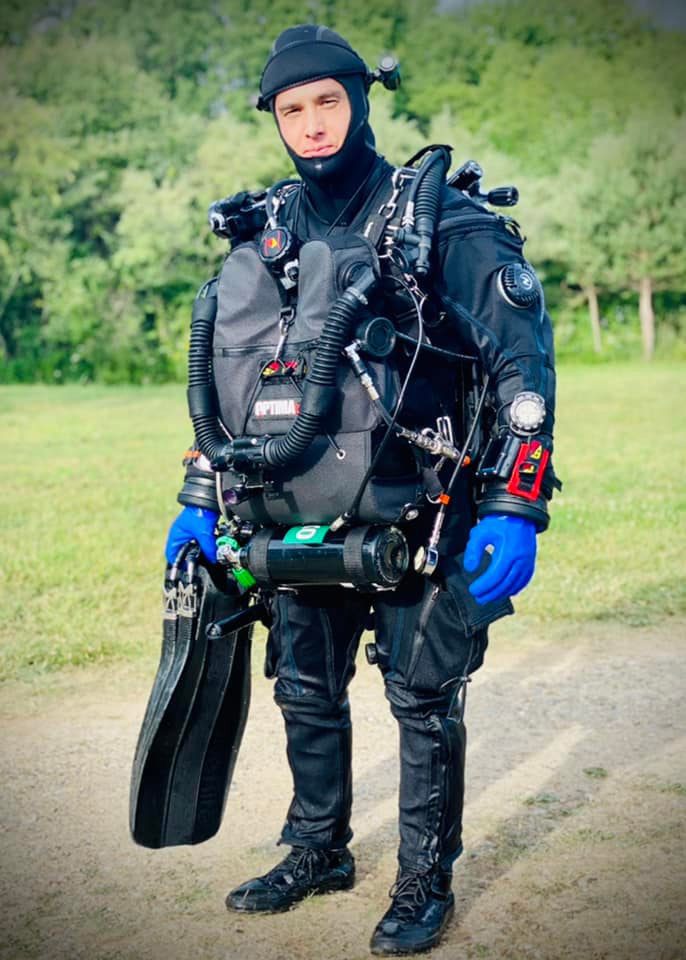
So, the CHO2ptima started out as an exploration tool for sidemount—a sidemount rebreather concept, but it has now evolved to become a travel rebreather, basically, or an add-on rebreather to any open circuit configuration. People are diving them with a single tank, doubles, and sidemount.
I don’t know if all our readers know this, but a chest-mounted counterlung is optimal from a work of breathing perspective, assuming that you’re in trim. That’s why combat divers, who kick long distances, wear chest-mounted oxygen rebreathers.
That’s right. One of our design philosophies with the CHO2ptima, and actually the O2ptima as well, has been to keep the breathing loop as short as possible. Even on the backmount unit, the scrubber is right behind the diver’s head. As a result, our hoses and the counterlungs can be smaller since it’s got a shorter breathing loop.
As you said, the lungs are right below your lungs, so also it’s not just the fact that the work of breathing is better, but even your change in buoyancy from breathing. That was one of the issues with sidemount rebreathers, the ones that go completely on your side. Every time you breathe, there is a slight shift in buoyancy and you will tilt to the side. Everyone will tell you that you just have to get used to it. But you can eliminate that by putting the lungs in the same exact position as your lungs as we did with the chestmount.
I know I felt relief went I went from over-the-shoulder counter lungs to back mounted counter lungs. How do your users feel about having the counter lungs over their chest? Does it feel cluttered or difficult to manuver?
I felt the same relief moving to backmounted lungs from the over the shoulder lungs on the O2ptima, and had some apprehension about the chest mounted ChO2ptima. The main relief felt with backmounted lungs is the ease of carrying bailout. You get the same relief with the chest mounted unit, especially if you’re using it with a backmount open circuit configuration. I can carry a lot more bailout comfortably with the ChO2ptima than I can with a BM unit.
With the way the counter lung bag is shaped, most of the bulkier parts are lower down, so you really have the free use of your hands, and the chestmount does not get in the way on working dives. Even when diving in sidemount, I have easy access to my drysuit inflation and power inflator.
The rebreather is attached to the diver’s existing open circuit rig and is set up so that the diver can actually remove it during the dive; for example, in order to go through a restriction. That’s totally unique in itself.
For sure! That was one of the features and purposes that we envisioned for the unit. Generally, when we design equipment, we have a purpose for it. We don’t just set out to say, “Hey, we want to make a new gadget.” I like to think that sets our equipment apart from other dive gear manufacturers. We don’t just come up with a new color for something and release it as a new product.
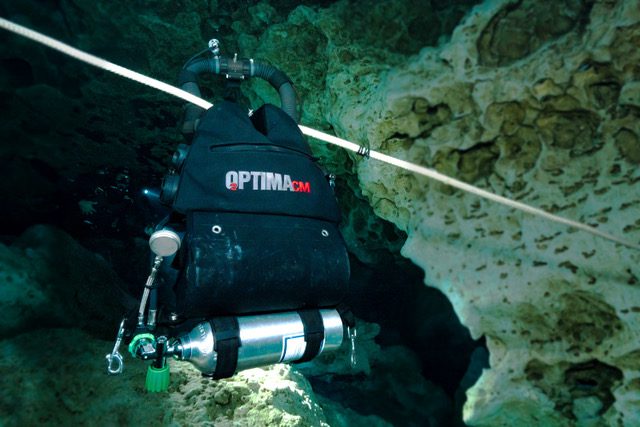
When we come up with something new, it has a purpose, whether it’s to make it easier to do a certain dive or alleviate a problem that divers have.
Lamar definitely had in mind the ability to remove the unit underwater when we were designing the CHO2ptima. There are a couple of exploration dives that he had left off and wanted to go back to.
Yes, in the interview we did a few years ago, I remember Lamar talking about going back to Cow Springs.
Yeah, his thought was, I want to be able to dive my rebreather all the way up to this tight restriction and basically remove and leave it, go through the restriction, do some exploration on open circuit going through these tight restrictions, come back out, grab my rebreather, and exit the cave. So, to do that, we wanted something that was completely independent.
We also thought about travel. If divers are traveling and/or diving with friends, maybe they don’t want to dedicate a whole dive trip to a rebreather or dedicate all their dives to a longer dive or a bigger dive. We do this all the time when we go down to the Keys, for example. So, maybe in the morning we’re going to do a deep wreck dive with some decompression. I can carry a single 95 on my back with my CHO2ptima on the front, and stage a deco bottle. But then, in the afternoon, maybe I’m with my wife or with friends that are just diving a single tank dive on Molasses Reef, and I don’t want to have the complexity of a rebreather added into that dive. So, I just leave the rebreather on the boat and still have my same full configuration. We do that quite often.
So, it gives the diver maximum flexibility. That makes sense. I was at Bonaire Tek last Fall, and friends showed up with their CHO2ptima in a little roll-away travel case. It was impressive.
That’s right, when I travel, the whole rebreather, plus extras, fits in a carry-on Pelican case. And it was not just the rebreather. I had lights and all kinds of extra stuff in the carry-on case and the rest of my dive gear can go into its normal suitcase. That’s it. The unit itself only weighs 7.7kg /17 lbs.
When I travel with my backmount unit, it takes a large suitcase for the rebreather and another one for my camera and the rest of my dive gear. I barely have room for two swimsuits.
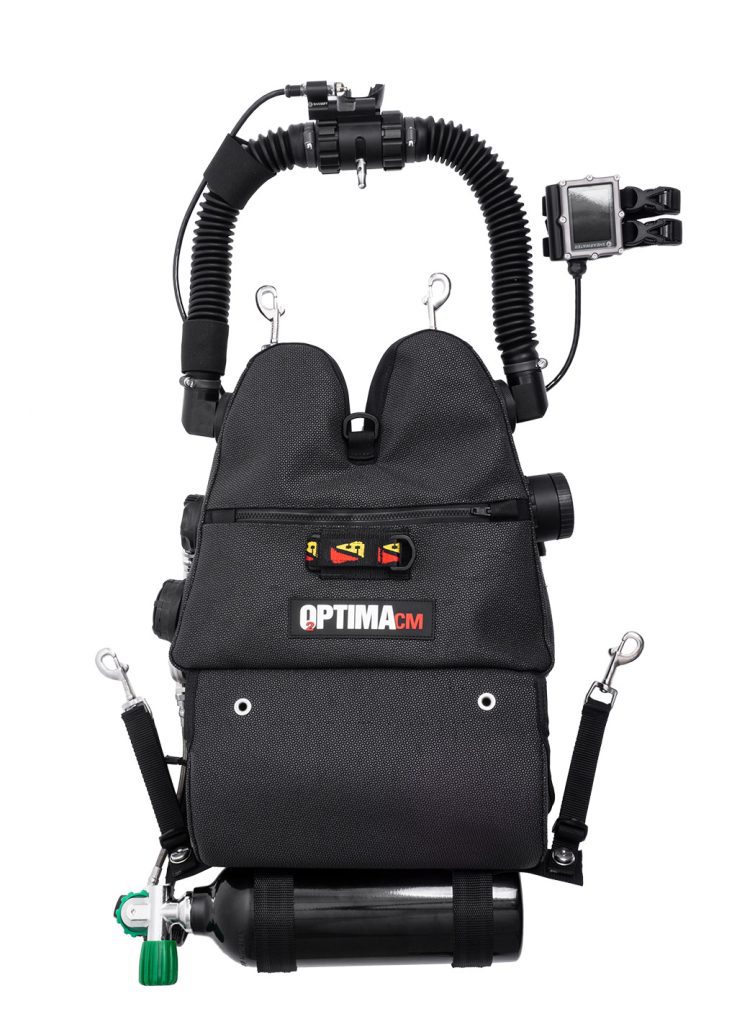
What I find most intriguing and unique is that the CHO2ptima can basically be worn with any sort of open circuit gear.
Yeah, to add the CHO2ptima to any harness, to any configuration, all it takes is two attachment points on your shoulders and two attachment points on your waist. Some people are able to use the D-rings that they already have on their harness. However, I usually add an additional set that I dedicate just to the unit because I like the top attachment points to be up closer to my clavicle. And then I just add an extra set of D rings to my bottom. Two clips on your shoulder straps and two clips on your waist strap is all you need to add the unit. Then there’s a single low pressure inflator hose or whip to plug the unit into your back gas or to your side mount tanks or whatever. The only thing extra on your kit is a single additional inflator hose.
The unit itself contains the scrubber, head, and oxygen cylinder.
That’s right. However, some people mount the O2 offboard, which you can do. You can carry your O2 as a stage cylinder, especially if you’re carrying a deco stage anyway, and you weren’t planning to drop it like some of the ocean guys do. So basically, everything else is self–contained except for a diluent feed hose.
What were some of the challenges in packing all that functionality into a very small space?
It was a bit like trying to pack 10 pounds of shit in a 5 pound bag. That was definitely a challenge, but we were not willing to sacrifice any features.
The scrubber is in the middle, and then you have the head on one side, and the cap on the other side is basically a water trap—it’s the same exact module that we use on the back-mounted O2ptima. So that was the easy part. One of the biggest challenges was designing the outer bag, so it would accommodate most divers. Something that would fit a really tall guy wouldn’t fit someone who was petite. So we had to do some work on that. The counterlung design was also a big challenge. We went through multiple iterations trying to find just the right size that would provide good work of breathing but not add too much to the size of the unit.
The lungs are inside the unit?
Yes, the whole bag assembly contains your inhale and exhalation counter lungs in the bag. We had to do a lot of work on the designs of those counter lungs to make it all work. And there were little things along the way. We worked through several renditions of water trap designs, and we went through several Diver Surface Valve (DSV) designs and changed up some of the fittings to make them work just right. We looked at using an actual sidemount type DSV where the fittings came off of the DSV and went down. We ended up putting the elbows on the actual bag instead of putting them on the DSV to give it more of a natural feel. We also changed bag materials and added a pocket for accessories.
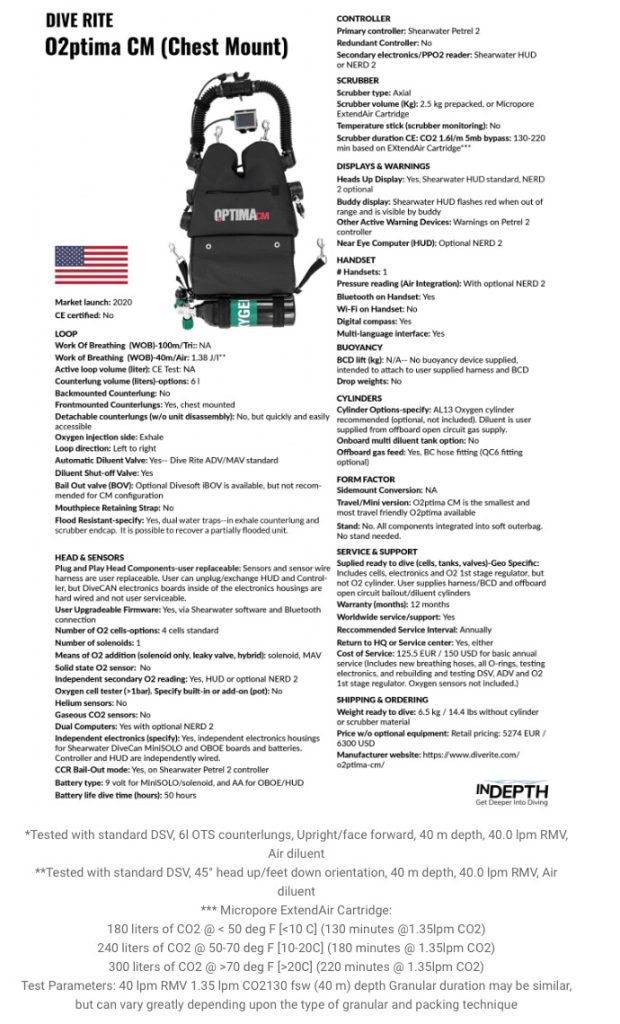
What about for women divers? Do their breasts get in the way?
Luckily, wetsuits and drysuits take care of most of that for us. They actually act like a corset. So that hasn’t really been too much of an issue. The only people that maybe struggle are the guys with the big beer belly. We have a few of those in the community, but even for those guys, the CHO2ptima works pretty well. Big guys, like myself, don’t have a problem. However, the one group that has problems with a stock unit without making modifications are super short people. Because of the actual length of the unit, they may have issues. But that’s just with the standard mounting hardware. Many of these people can make a few adjustments to a stock CHO2ptima and have zero issues.
I see that you are also continuing with the Micropore scrubber cartridges, which are basically pre-packed scrubber cartridges that eliminate the need to hand pack the scrubber with sorb. I know that the military loves them. Are there other civilian rebreathers that use them?
I think we are currently the only vendor that is actively promoting the use of cartridges with their unit. When we first started using the Micropore cartridge in the early 2000s, there were some other ones. Most notably KISS had started using the cartridge—they actually made some units that were only able to work with the cartridge. Another was the Titan rebreather.
The French chest-mounted rebreather?
No, not the Triton but the Titan—the original one that was basically a backpack. It used Micropore cartridges. And we built the original O2ptima with the idea of using cartridges. At that time, 2003, 2004, the idea of cartridges was starting to pick up steam. So, there were a few units that used them, and divers were also making adapters for the AP Diving’s Inspiration, which was one of the first commercially available mixed-gas units on the market, as well as a few other rebreathers, so that they could use the Micropore cartridge.
We bought into the concept, and still do—we think it’s the right way to do it. You remove the potential for user error in filling the scrubber, and it’s consistent and solid. That’s what’s written on the packaging, “A Solid Choice,” because you don’t have granules to deal with. Everything is exactly the same. People were using the extender cartridges because of the benefits. A lot of O2ptima users tell us that the cartridges are one of the reasons they like the unit. Of course, both the O2ptima and CHO2ptima unit can use granular sorb as well, so you are not locked into the Micropore cartridge.
You can do either one?
Exactly. Our scrubber was actually designed in collaboration with Micropore to give our unit the best work of breathing, the best duration and the best efficiency with the cartridge. So that was the main goal.
At the time, the mid-2000s, there was a big after market for conversions. A lot of divers were upgrading their units with Hammerhead Electronics, which was the gold standard of the day, and many were also having us add Dive Rite harnesses and buoyancy devices to their units, and as I mentioned, many were adding adapters to be able to use cartridges.
Let me ask you about electronics. I know that you started with Hammerhead electronics on the O2ptima, but then eventually migrated to Shearwater electronics, which of course has become the de-facto standard in the tech market.
Yes, Hammerhead was a collaborator of ours. Our original units had Hammerhead electronics. We used them all the way up until about 2013. I believe it was the very beginning of 2013 when we made the switch to Shearwater. So, we had a long relationship with Hammerhead, and a great relationship with founder Kevin Jurgensen. He remains one of the pioneers in the rebreather world, and he’s a great guy. Unfortunately, there were others that came to market, and they were not able to keep up.
Shearwater was able to bring new technology to the market, both with their computers and rebreather controllers. They created a lot of buzz when they released the Predator in 2009 and they continue to do so.
I think JJ-CCR was the first rebreather manufacturer to go with Shearwater.
Yes, I believe JJ was first. Then others such as rEvo and Hollis started integrating them as well. After the Predator was released, we had many divers asking us to integrate them into the O2ptima. Some sent us in Fisher connectors to attach to their rebreathers so they could run a secondary Shearwater computer. A lot of our instructors and distributors were big Shearwater fans.
We finally met with Shearwater at the DEMA tradeshow in 2012. Later that year we got our first set of electronics, added them to the O2ptima and started doing test dives through the early part of 2013. I think we actually released the new unit at Beneath The Sea (BTS) 2013 using DiveCan and the Petrel controller.
I have a few more questions about electronics. Solid-state oxygen sensors? Is that something you are looking at, thinking about?
If they ever become readily available, yeah, we would look at them. And if Shearwater bought into the concept and integrated them into their technology, then we would, of course, look at it. We take the lead from them when it comes to sensor technology. Solid state sounds cool in theory. The thing is, you always have to have redundancy, so you’d need two of them at least. For sure, it would be awesome if you didn’t have to change out your sensors every 12 months.
How about scrubber thermal sticks and gaseous CO2 sensors.
The sticks are not really CO2 sensors, but they do measure scrubber duration.
Right. They’re distinct from gaseous sensors. Only a few vendors are using either of these.
Thermal sticks are being used by a couple of manufacturers, most notably AP and rEVO. They track scrubber usage by looking at the temperature fluctuations caused by the chemical reaction of the scrubber. Thermal sticks tend to be an add on upgrade and not standard.
Some companies are also starting to use CO2 sensors as well, though they have not been widely adopted yet. The issue that we have seen with CO2 sensors is that they’re large. So, integrating one into a small package rebreather is hard. Another issue is that they don’t like moisture, and a rebreather is inherently a moist environment. The byproduct of the reaction in the scrubber is moisture— water and heat. They require extra precautions and consumables like desiccant packs to absorb the moisture. If those precautions are not strictly followed the sensors can produce false alarms. Eventually, if a diver gets too many false alarms, they become complacent and ignore the alarms altogether.
Right.
I know of many instructors who tell their students not to buy the CO2 sensor upgrades due to their finicky nature. Especially if diving in high humidity environments like the Caribbean.
But, when someone comes out with a sensor that is smaller and more reliable i.e., more humidity tolerant, then I think it would make a good additional alert. Remember that scrubber breakthrough is not completely linear. Breakthrough is exponential at the end of the scrubber life. When it breaks through, it’s an, “Oh Shit Moment,” and you need to bail out right away.
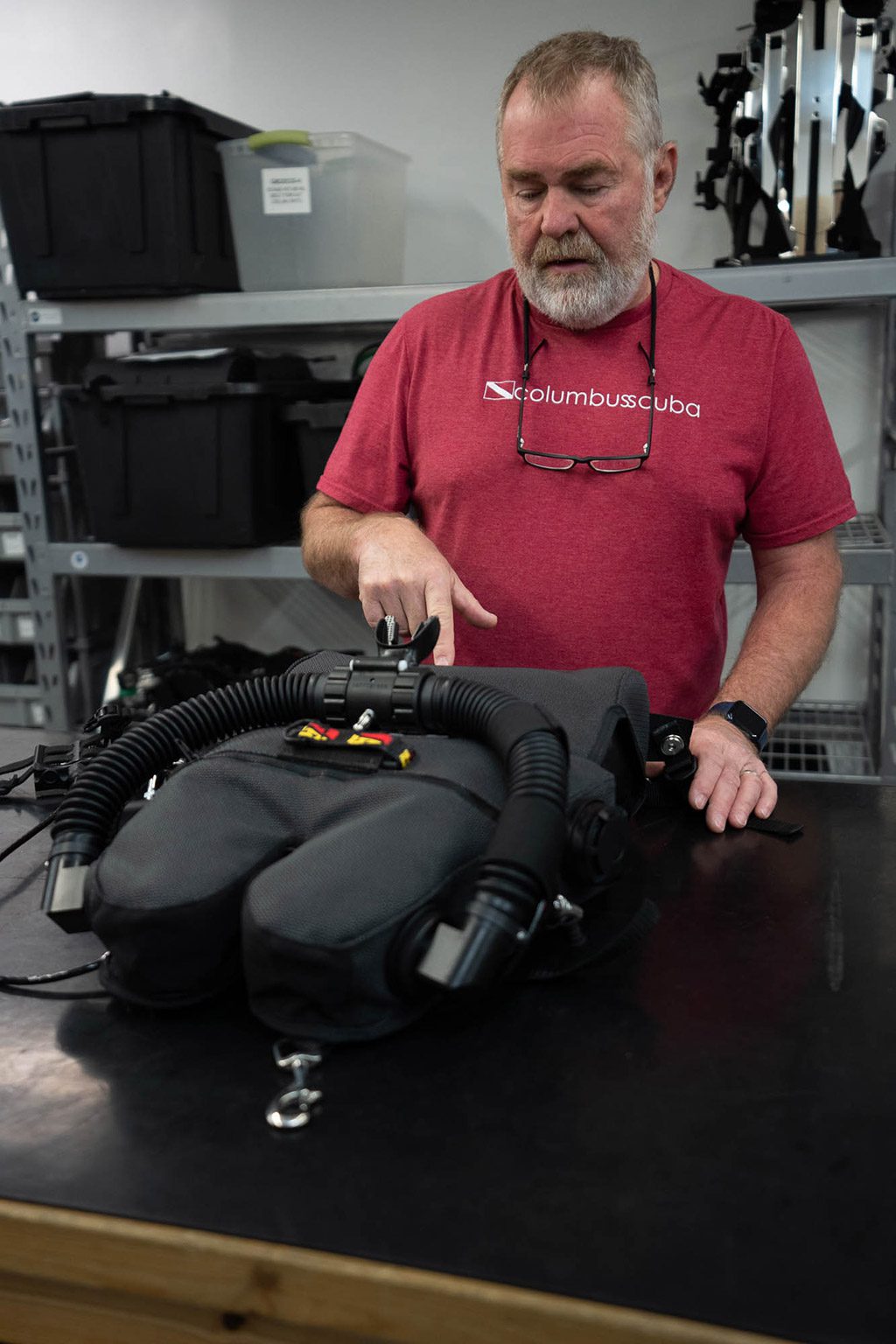
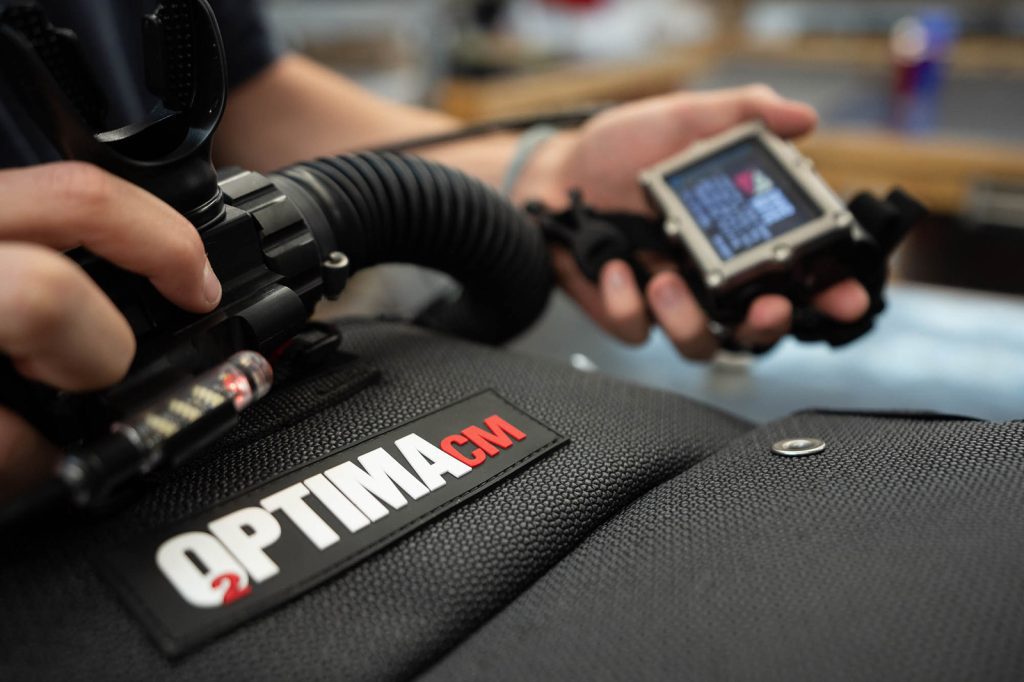
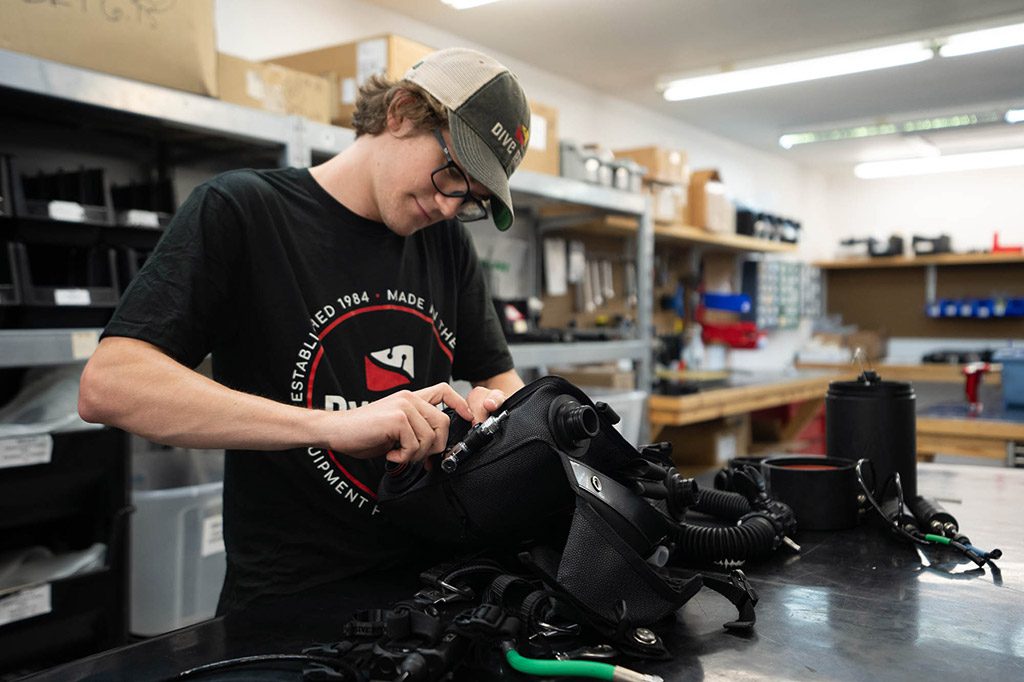
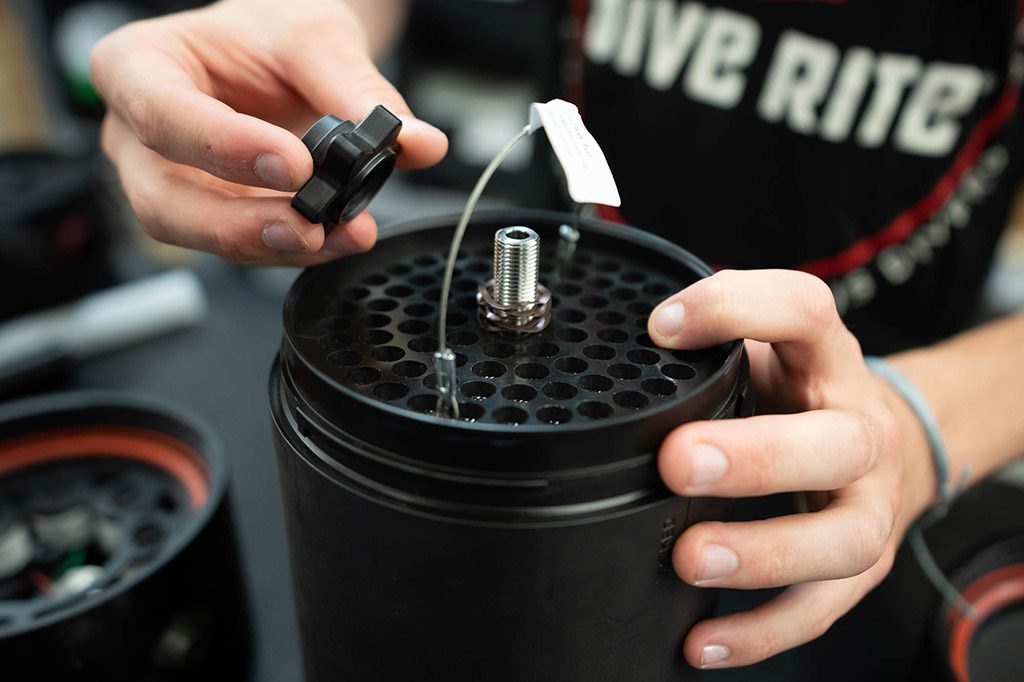
Let’s talk about building the unit. You build the CHO2ptima in the US right?
The ChO2ptima is assembled right here at our headquarters in Lake City, FL. We partner with other small companies here in the US for our machined parts and sewn pieces. But everything is brought into our factory in pieces to be assembled from scratch and to go through the rigorous final quality control check.
The most tedious part is integrating the raw electronics that do come from Shearwater in Canada. From start to finish, a single rebreather head takes a minimum of 3 days to go through the different steps. This includes multiple components that are potted and over 300 solder points.
Made in America! That will no doubt appeal to some users. Talk to me about who is actually using the CHO2ptima.
The ChO2ptima is worldwide with divers across North America, South America, Asia, and Australia. This is one of the areas the pandemic hurt us with the launch, because instructors were not able to travel as easily to get up to speed on the new unit. That’s why we have started with a better stronghold here in the US because we could reach those instructors easily.
We are starting to get some interest in Europe and have a few divers using the unit there, but it’s limited because the unit is not currently CE approved. This may be something we pursue in the future for a bigger expansion.
I’ve heard that the cost of CE testing is somewhere between US$50,000-US$100,000.
We have gone through CE testing for many of our products over the years and based on those experiences, the figure is more on the high end of your range. It is a lot harder and more expensive for non-European companies to do as well. The issue is that you have to pay for the testing to be done at a European facility most of the time and then do all the paperwork and the documentation to their liking. A lot goes into it besides what the test house does, which adds even more to the cost
We do know that Rebreathers require proper testing before divers can trust them with their lives. We’ve done all the main CE tests through a third-party testing facility here in the US called Dive Lab. We have a blog on our website that has all the results from that and some pictures of it going through testing if you want to take a look at that. That would be in addition to the hundreds of actual dive hours on the unit by our in-house test divers, myself included.
Another neat aspect about our relationship with Micropore, is they actually have testing machine on site, based off the testing machines used at the US Navy Experimental Diving Unit. We do a lot of testing there. Every time they do a production run of scrubber material, they do a quality control check of the scrubber material in a Dive Rite rebreather, whether it’s the back-mounted O2ptima or the CHO2ptima, in the ANTSI testing machine. I don’t think many other sorb companies are testing their product in an actual rebreather for quality control after a production run, which is kind of cool.
It is! What agencies support CHO2ptima training?
A number of them, though I would say that TDI and IANTD are the main ones. Most of the instructors have a TDI or IANTD qualification, and some have additional ones on top of that. I know that we have a couple of PSAI instructors and a few PADI instructors that can teach Tec 40 and up on the unit. Global Underwater Explorers (GUE), of course, only teaches its specially configured JJ-CCR and the RB-80.
Interestingly, the CHO2ptima is actually broadly compatible with GUE’s CCR configuration i.e., two diluent cylinders in doubles configuration with a long hose and secondary in addition to the loop, when worn with doubles. (See “The Thought Process Behind GUE’s CCR Configuration”)
I dive a DIR configuration on my doubles kit. You’re looking at a card-carrying Fundamentals diver, though I haven’t done anything past that, but I dive a DIR setup for sure. With the CHO2ptima you can easily dive it in a DIR configuration. And probably a little bit easier than you can even with JJ-CCR. It’s a lot easier to deploy a long hose—you don’t actually have to bail out to deploy it with the CHO2ptima, which we’ve already known has caused issues. There have been people that have flooded units in the process of trying to donate gas.
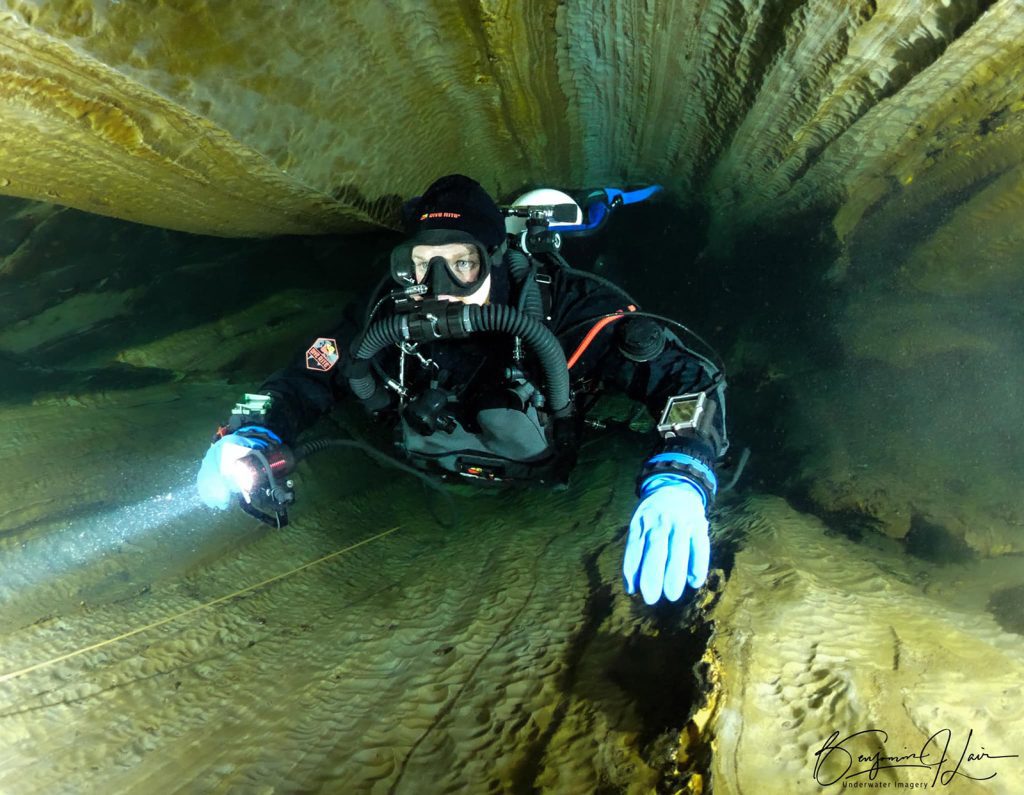
Practice, practice, practice, right?!? We covered the development and working of the CHO2ptima. Talk to me about some of the exploration that’s being done. I know that people like Steve Lambert are doing some incredible new stuff at Peacock Springs. [See: The Taming of the Slough: P3 Edition]. Talk to me about some of the projects people are using these for.
We’re lucky. People like Steve are doing some really cool stuff with the unit. He’s was one of the catalysts that helped push the ChO2ptima over the finish line when he came to work for us. He was excited about using the CHO2ptima just like Dad and a couple of the other guys were. He volunteered to be one of the test divers and immediately started doing big dives with it.
He’s been doing some great exploration and has gotten a couple of his buddies from Karst Underwater Research (KUR) and “Beyond the Sump” into CHO2ptimas. They just came back from that expedition in Huautla (See: Sump Potion No. 9). They had two divers on CHO2ptimas, one on a KISS sidewinder, one on a JJ-CCR and two of them on Fathom units. So the CHO2ptima was well represented down there and they were doing some awesome dives with that.
They’ve been working hard in Peacock and exploring in Peacock 3 down deep in Henley’s Castle. They also did some really deep exploration at Chaplain in early 2021, which is another deep spring up here and I was lucky enough to do one dive with those guys. It’s 55 m/180 ft deep for most of it—a deep river cave. We also have people who are doing deep ocean dives with them. Ben Lair, one of our CHO2ptima instructors based in Arizona, has done a number of deep wrecks in the 92 m/300 ft plus with the unit. So, there definitely are people that are doing some cool stuff with it. It’s not just doing tourist dives, that’s for sure.
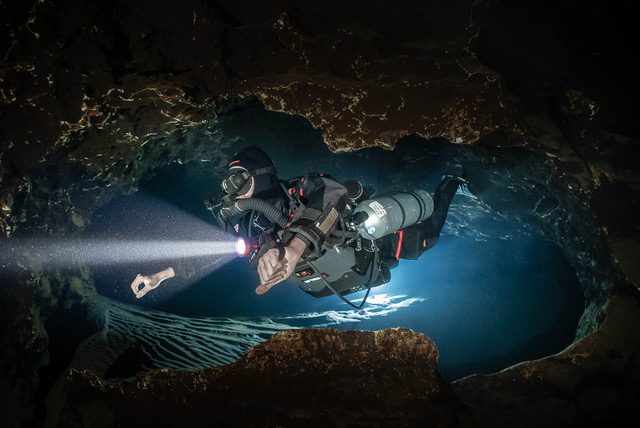
And how about Lamar? Wasn’t he planning to use one at Cow Springs?
Yeah, Cow was one of the big ones that he wanted to do. And he’s gone back and has definitely checked out those leads that the CHO2ptima was designed for. Unfortunately, I guess he let the cat out of the bag to a couple of his friends that also went and checked out the leads before he could.
Ha! I guess you have to keep your mouth shut in cave country! Thanks for taking us through the unit, Jared. Wishing you continued success with your rebreathers.
See our companion story, Taming the Slough: P3 Edition by Steve Lambert
Dive Deeper
CM Instructors: O2ptima CM Community Page
TDI blog: BUILD IT AND THEY WILL COME (CAVE DIVING): AN INTERVIEW WITH CONSUMMATE UNDERGROUND GEARHEAD LAMAR HIRES by Michael Menduno
CHO2ptima Reviews:
PodDiver Radio: Optima CM: Chest-mounted CCR Review
Dive Addiction: ChOptima ECCR Review (Dive Rite Optima CM)
The Dive Locker: Chest-mounted Rebreather Dive! Choptima (O2ptima CM) Action!
For more information on scrubber cartridges: Micropore

Michael Menduno/M2 is InDepth’s editor-in-chief and an award-winning journalist and technologist who has written about diving and diving technology for more than 30 years. He coined the term “technical diving.” His magazine “aquaCORPS: The Journal for Technical Diving” (1990-1996) helped usher tech diving into mainstream sports diving, and he produced the first tek.Conferences and Rebreather Forums 1.0 & 2.0. In addition to InDepth, Menduno serves as an editor/reporter for DAN Europe’s Alert Diver magazine, a contributing editor for X-Ray mag, and writes for DeeperBlue.com. He is on the board of the Historical Diving Society (USA), and a member of the Rebreather Training Council.



















